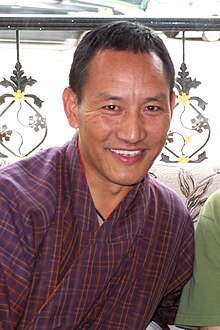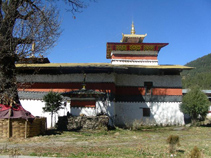
Ngawang Namgyal and known colloquially as The Bearded Lama, was a Tibetan Buddhist lama and the unifier of Bhutan as a nation-state. In addition to unifying the various warring fiefdoms for the first time in the 1630s, he also sought to create a distinct Bhutanese cultural identity separate from the Tibetan culture from which it was derived.
Articles related to Bhutan include:

Kyabje Khenchen Jigme Phuntsok,, was a Nyingma lama and Terton from Sertha Region. His family were Tibetan nomads. At the age of five he was recognized "as a reincarnation of Lerab Lingpa. Known also as Nyala Sogyel and Terton Sogyel, Lerab Lingpa was an eclectic and highly influential tantric visionary from the eastern Tibetan area of Nyarong ." He studied Dzogchen at Nubzor Monastery, received novice ordination at 14, and full ordination at 22. In 1980, he founded Larung Gar, the largest Tibetan Buddhist monastic academy.

Kyabje Dudjom Jigdral Yeshe Dorje was known as Terchen Drodül Lingpa and as Dudjom Rinpoche. He is considered by many Tibetan Buddhists to be from a line of important Tulku lineage, and a renowned Tertön. Per lineage, he was a direct incarnation of both Padmasambhava and Dudjom Lingpa (1835–1904). He was a Nyingma householder, yogi, and a Vajrayana and Dzogchen master. According to his disciple Khenpo Tsewang Dongyal, he was revered as "His Holiness" and as a "Master of Masters".

Pema Lingpa or Padma Lingpa was a Bhutanese saint and siddha of the Nyingma school of Tibetan Buddhism. He is considered a terchen or "preeminent tertön" and is considered to be foremost of the "Five Tertön Kings". In the history of the Nyingma school in Bhutan, Pema Lingpa is second only in importance to Padmasambhava.
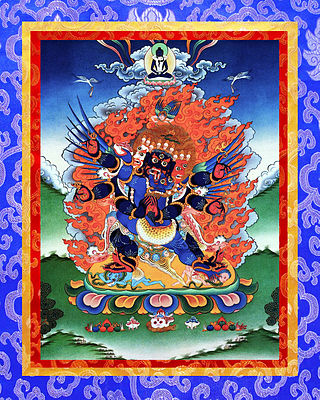
In Tibetan Buddhism, Vajrakilaya or Vajrakumara is a wrathful heruka yidam deity who embodies the enlightened activity of all the Buddhas. His practice is known for being the most powerful for removing obstacles and destroying the forces hostile to compassion. Vajrakilaya is one of the eight deities of Kagyé.
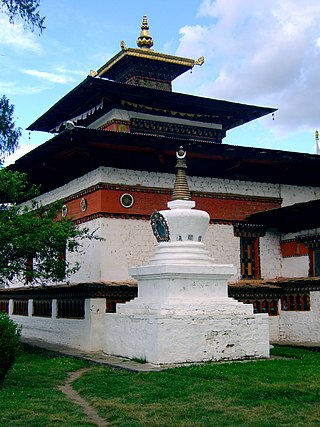
Kyichu Lhakhang, is an important Himalayan Buddhist temple situated in Lango Gewog of Paro District in Bhutan.

Chagri Dorjeden Monastery, also called Cheri Monastery, is a Buddhist monastery in Bhutan established in 1620 by Ngawang Namgyal, 1st Zhabdrung Rinpoche, the founder of the Bhutanese state.

The Second Tibetan Invasion of Bhutan or the Second Battle of Simtokha Dzong was a military confrontation in 1634 between the supporters of Zhabdrung Ngawang Namgyal and the forces of the Tibetan Tsangpa dynasty and several Bhutanese lamas allied against him. The latter initially conquered Zhabdrung's seat, Simtokha Dzong, threatening to eliminate his young dominion. The castle's ammunition stores were accidentally ignited during the battle, however, resulting in an explosion that destroyed Simtokha Dzong and much of the Tibetan army. Seizing this chance, Zhabdrung's followers rallied and ousted the Tibetans from their territory, turning the battle into a decisive strategic victory of Ngawang Namgyal, paving the way for the Unification of Bhutan under his rule.
Rongzom Chökyi Zangpo, widely known as Rongzom Mahapandita, Rongzom Dharmabhadra, or simply as Rongzompa, was one of the most important scholars of the Nyingma school of Tibetan Buddhism. Together with Longchenpa and Ju Mipham, he is often considered to be one of the three "omniscient" writers of the school. His elder contemporary Atiśa (980–1054) considered Rongzompa to be an incarnation of the Indian ācārya Kṛṣṇapāda, the Great. The Tibetan historian Gö Lotsawa (1392–1481) said of Rongzom that no scholar in Tibet was his equal.
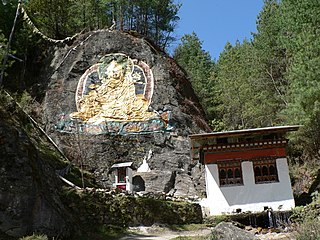
Bhutanese art is similar to Tibetan art. Both are based upon Vajrayana Buddhism and its pantheon of teachers and divine beings.
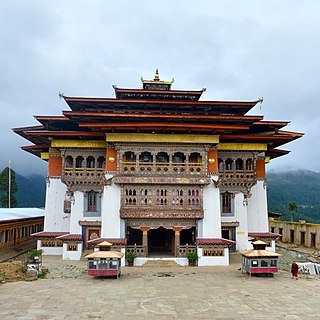
The Gangteng Monastery, generally known as Gangtey Gonpa or Gangtey Monastery, is an important monastery of Nyingmapa school of Buddhism, the main seat of the Pema Lingpa tradition. located in the Wangdue Phodrang District in central Bhutan. The Monastery, also known by the Gangten village that surrounds it, is in the Phobjikha Valley where winter visitors – the black-necked cranes – visit central Bhutan to roost, circling the monastery three times on arrival and repeating this circling when returning to Tibet. The Monastery's history traces to the early 17th century and back to the prophecies made by the well-known Terton Pema Lingpa in the late 15th century.
Loden Foundation (བློ་ལྡེན་གཞི་ཚོགས་) is a registered Civil Society Organisation in Bhutan established to support education, promote entrepreneurship amongst the young Bhutanese men and women in Bhutan and promote Bhutan tradition and culture. Its three core programmes areas include the Loden Education Initiatives, Loden Entrepreneurship Programme, and Loden Culture Programme.

Desi Jigme Namgyal of Bhutan is a forefather of the Wangchuck Dynasty. He served as 48th Druk Desi of Bhutan (1870–1873), and held the hereditary post of 10th Penlop of Trongsa. He was called the Black Ruler.
Pagsam Wangpo, a key figure in the history of the Drukpa Lineage of Tibetan Buddhism, was born at Chonggye, in the Tsang province of Tibet a natural son of the prince of Chonggye, Ngawang Sonam Dragpa. He was an elder cousin of the 5th Dalai Lama, Ngawang Lobzang Gyatso (1617-1682).
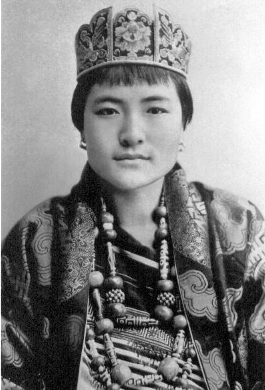
Ashi Phuntsho Choden (1911–2003) was the Queen consort of Bhutan.
Gyurme Dorje was a Scottish Tibetologist and writer.
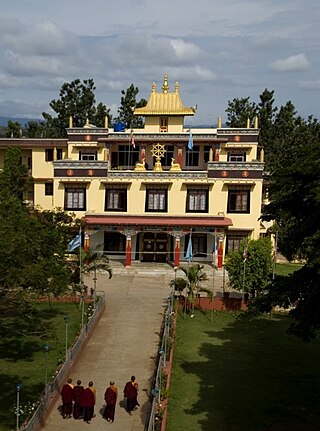
The Ngagyur Nyingma Institute of Namdroling Monastery was established by Penor Rinpoche in 1978.
The Bumthangpa or Bumthang people are an ethnic group of central Bhutan primarily living in the four main valleys, namely Ura, Chumey, Tang and Choekhor in Bumthang district. They speak the Bumthangkha or Bumthang language, a member of the extended Sino-Tibetan language family. It is mutually intelligible with the Kheng language to the south and also to some extent with the Kurtöp language to the north. Linguist van Driem postulated that Khengkha, Bumthangkha, and Kurtöpkha are dialects of what he calls "a single Greater Bumthang" language.
